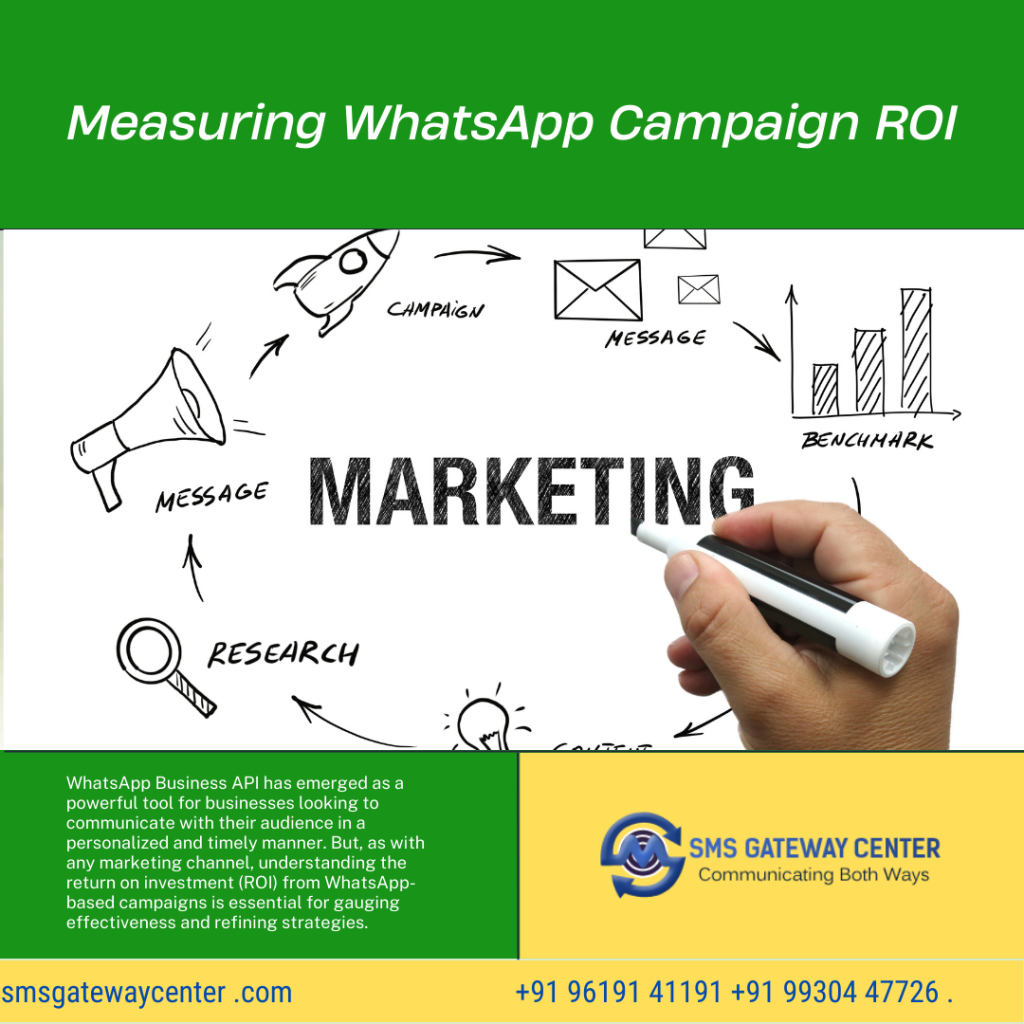How to Measure the ROI of Your WhatsApp Business Campaigns: A Complete Guide
In the rapidly evolving digital landscape, businesses are constantly seeking more direct and effective ways to engage with customers. WhatsApp Business API has emerged as a powerful tool for businesses looking to communicate with their audience in a personalized and timely manner. But, as with any marketing channel, understanding the return on investment (ROI) from WhatsApp-based campaigns is essential for gauging effectiveness and refining strategies.
In this blog post, we’ll break down how you can measure the ROI of your WhatsApp Business campaigns and offer tips on tracking Key Performance Indicators (KPIs) to ensure you’re maximizing the potential of this communication channel.

What is WhatsApp Business API?
Before diving into ROI measurement, it’s important to understand the scope of WhatsApp Business API. It allows businesses to send messages, notifications, and updates directly to customers through WhatsApp, a platform with over 2 billion active users worldwide. Whether you’re using it for customer service, marketing promotions, or transactional notifications, the API provides businesses with an effective communication channel, allowing them to engage with users in a medium they are already comfortable with.
Why Measure ROI in WhatsApp Campaigns?
Measuring the ROI of any marketing campaign is crucial to understanding whether the investment in resources, time, and effort is yielding positive returns. For WhatsApp Business campaigns, tracking ROI is even more important because these campaigns offer a direct line to customers. Evaluating performance helps you understand what’s working, what isn’t, and how to optimize future efforts.
Key Metrics to Track for WhatsApp Campaign ROI
To calculate ROI effectively, you’ll need to track several Key Performance Indicators (KPIs) that reflect the performance of your WhatsApp campaigns. Here are some important ones to consider:
1. Message Open Rate
One of the most significant advantages of using WhatsApp is its high message open rate. Unlike email campaigns that may often get ignored or filtered into spam folders, WhatsApp messages are more likely to be seen by recipients. Tracking the open rate of your messages is crucial as it directly reflects the level of engagement with your audience.
- How to Track: You can measure this by dividing the number of opened messages by the number of messages sent and multiplying by 100.
2. Response Rate
The response rate is a key indicator of how well your campaign resonates with your audience. A high response rate shows that recipients are not only reading your messages but also engaging with them.
- How to Track: Similar to open rates, calculate this by dividing the number of responses received by the total messages sent and multiplying by 100.
3. Conversion Rate
Ultimately, the success of any campaign depends on conversions. Whether your goal is to drive sales, gather sign-ups, or increase event attendance, tracking how many recipients took the desired action is critical.
- How to Track: Measure this by dividing the number of conversions (e.g., sales or sign-ups) by the total number of messages sent.
4. Click-Through Rate (CTR)
If your WhatsApp message includes a link, tracking the Click-Through Rate (CTR) is another important metric. A high CTR indicates that your message content was compelling enough to encourage recipients to take further action by visiting your website or landing page.
- How to Track: Divide the number of unique clicks by the number of messages sent, and multiply by 100.
5. Customer Retention Rate
WhatsApp Business campaigns are highly personalized and conversational, making them a great tool for fostering long-term customer relationships. Tracking how well you retain customers who have interacted with your campaign can provide insights into the long-term value WhatsApp delivers.
- How to Track: Measure this by identifying the percentage of customers who made repeat purchases or engaged with your business over time following the campaign.
6. Cost Per Conversion
One of the more direct methods for calculating ROI is determining the cost per conversion. This involves identifying how much you are spending on your WhatsApp campaigns and dividing that by the number of conversions achieved.
- How to Track: Take the total campaign cost (including time, resources, and advertising spend) and divide it by the number of conversions.
Calculating the ROI of WhatsApp Business Campaigns
Once you have tracked these KPIs, calculating ROI becomes more straightforward. The basic formula for ROI is:
ROI (%) = [(Revenue from Conversions - Campaign Cost) / Campaign Cost] x 100Let’s break this down further:
- Revenue from Conversions: This is the total revenue generated from conversions (e.g., sales, sign-ups, or another measurable action) as a result of your WhatsApp campaign.
- Campaign Cost: This includes all expenses related to the campaign, including costs of message delivery via the WhatsApp API, resource allocation, labor, and any third-party services.
Tips for Improving Your WhatsApp Campaign ROI
While tracking and calculating ROI is crucial, optimizing your campaigns for maximum ROI is just as important. Here are a few tips to help you enhance the performance of your WhatsApp campaigns:
1. Segment Your Audience
Not every message is relevant to every customer. Segment your audience based on their previous interactions, purchase history, or interests to send more personalized and targeted messages. Doing so increases the likelihood of engagement and conversion.
2. Use Rich Media
WhatsApp allows businesses to send images, videos, and other rich media that can make your message stand out. For example, sending a video showcasing your product or a compelling image of a promotional offer can encourage users to take action.
3. Optimize Timing
The timing of your messages plays a critical role in your campaign’s success. Ensure you send messages when your audience is most likely to be online and responsive. For example, sending promotional messages during business hours or on weekends can increase engagement.
4. A/B Test Your Campaigns
Just like with other digital marketing platforms, A/B testing can help you identify which message formats, content, or timings resonate best with your audience. Test different variables such as call-to-action phrases, images, or messaging formats to see which performs better.
5. Provide Exclusive Offers
Make your WhatsApp channel a valuable space for your customers by offering exclusive deals or promotions. This encourages customers to engage with your messages and boosts conversion rates.
Conclusion
WhatsApp Business campaigns are a powerful tool for engaging with customers in a direct, personalized, and timely manner. However, to truly maximize the potential of this channel, it’s essential to track and calculate your ROI. By focusing on the right KPIs—such as open rates, response rates, conversion rates, and cost per conversion—you can effectively measure how well your campaigns are performing. Use the tips we’ve discussed to optimize your WhatsApp marketing strategies and see improved ROI over time.
If you’re looking to start or improve your WhatsApp Business campaigns, visit SMSGatewayCenter.com for more information on how we can support your business needs.

